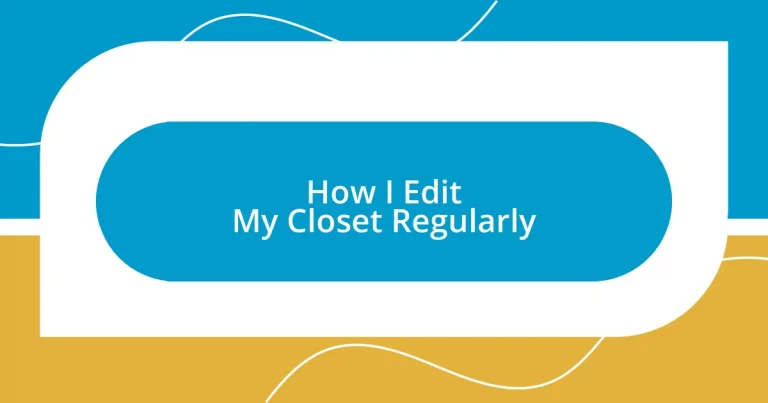Key takeaways:
- Regular closet editing enhances personal style, reduces decision fatigue, and supports sustainable fashion practices.
- Key signs it’s time to edit include outgrown sizes, worn-out items, and pieces not worn in over a year.
- The editing process involves emptying the closet, categorizing clothes, and assessing each item based on joy and fit.
- Maintain a minimalist closet by routine check-ins, investing in quality items, and creating an organized system for clothing storage.
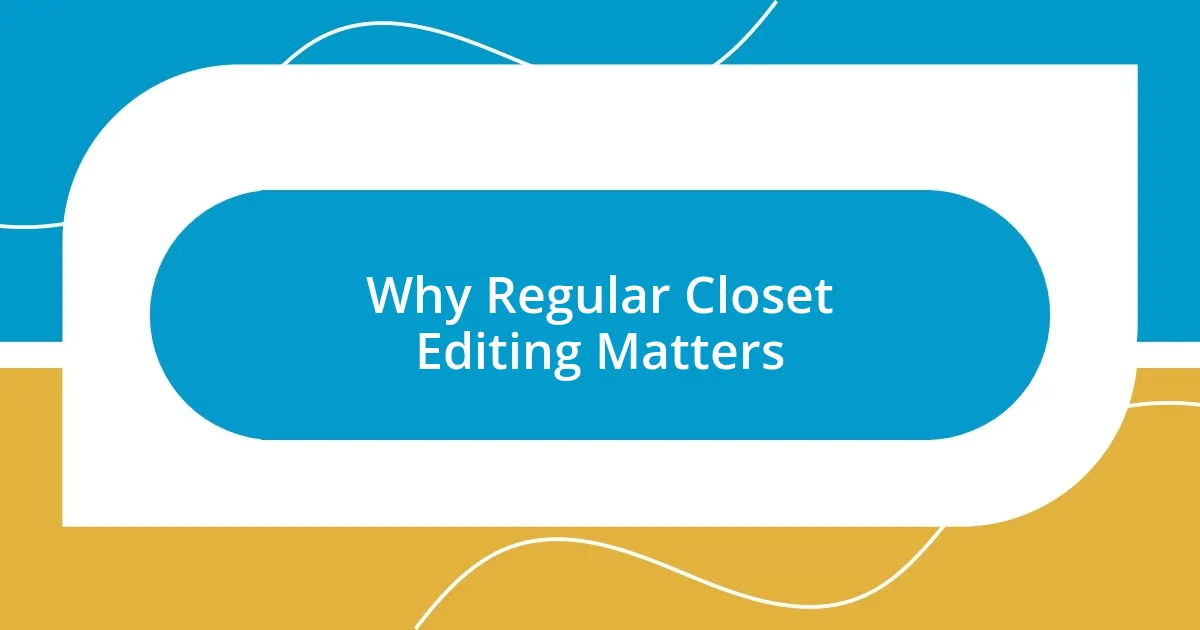
Why Regular Closet Editing Matters
Regular closet editing is essential because it brings clarity to my style and helps me rediscover pieces I truly love. I remember the first time I tackled my closet; it felt like unearthing a treasure trove! I found a sweater I hadn’t worn in ages that instantly uplifted my mood when I tried it on again. Isn’t it amazing how re-evaluating our possessions can spark joy and creativity?
Additionally, maintaining an edited closet reduces decision fatigue. Have you ever stood in front of a crowded wardrobe, overwhelmed by choices? I certainly have. When I streamlined my pieces, getting dressed became a breeze—I can now make decisions quickly, focusing on outfits that reflect who I am today rather than who I was last season.
Moreover, regular editing supports sustainable practices. It allows me to donate clothes that no longer serve a purpose in my life, making room for new favorites. It’s incredibly fulfilling to think that each item I pass on can find a new home, and it fuels my conscience in contributing to a more environmentally friendly approach to fashion. So, why hold on to things that don’t resonate with us anymore?

Signs It’s Time to Edit
There are unmistakable signs that it’s time to dive into my closet editing routine. One of the earliest indicators for me is when certain pieces start to collect dust. I can recall a denim jacket that I adored but eventually found tucked away on a shelf, forgotten and forlorn. Not only did it remind me of my crowded closet, but it also made me realize it no longer aligned with my style.
Here are a few telltale signs that signal the need for a closet edit:
- Outgrown Sizes: If clothes no longer fit comfortably, it’s time to let go.
- Worn-Out Items: Frayed edges or faded colors indicate it might be time to part ways.
- Items You Haven’t Worn in Over a Year: If you can’t remember the last time you wore an item, it’s likely not serving you.
- Wardrobe Stress: Feeling overwhelmed every time you open the door can signify it’s time for a change.
- Lack of Versatility: Clothes that don’t mix and match with your other pieces create clutter, not style.
Recognizing these signs is a pivotal moment that often reignites my passion for fashion and allows me to curate a collection that truly reflects who I am right now.

Step-by-Step Editing Process
To effectively edit my closet, I follow a simple step-by-step process that I’ve honed over the years. First, I empty out everything. I remember the first time I did this; it felt liberating to see all my clothes laid out, almost like a visual catalog of my style journey. It allows me to evaluate each piece more critically without the distraction of other items crowding my decisions.
Once everything is sorted, I categorize the items by type and season, which helps me gain better insight into what I have. I can’t stress how eye-opening this was the first time I realized I owned five pairs of black pants! This method not only uncovers duplicates but also draws attention to the gaps in my wardrobe that I hadn’t noticed before.
Finally, I assess each item based on its condition, fit, and how it resonates with my current style. If it sparks joy, it stays; if not, it earns a gentle farewell. I often feel a mix of nostalgia and relief during this phase, reminiscent of letting go of a favorite childhood toy. Reflecting on each piece establishes a deeper connection to my wardrobe while making space for the new.
| Step | Description |
|---|---|
| 1. Empty the Closet | Lay everything out to evaluate all pieces critically. |
| 2. Categorize Items | Sort clothes by type and season for better insight. |
| 3. Assess Each Piece | Decide what to keep based on joy, fit, and condition. |
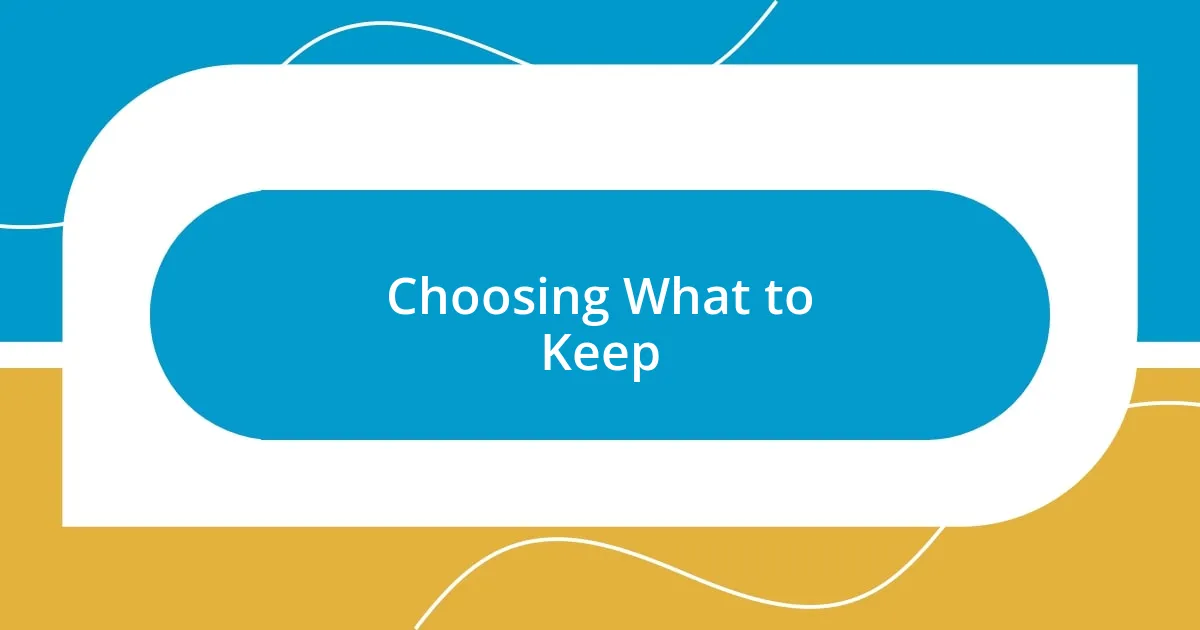
Choosing What to Keep
When it comes to deciding what to keep, I often ask myself a simple question: “Does this piece make me feel good?” I remember finding a bold red dress hidden in the back of my closet. The moment I put it on, it was like slipping into a burst of confidence. I realized that clothes should invigorate my spirit, not weigh it down.
I also think about the memories attached to each item. For instance, I have a cozy gray cardigan that I wore during a memorable road trip with friends. While it may not be the most fashionable piece, it carries warmth and laughter that make it irreplaceable. Does your wardrobe have pieces that tell your story?
Balancing practicality and sentimentality can be tricky. I often create a ‘maybe’ pile for items I’m unsure about; I label it with a date, usually six months out. If I haven’t reached for those items by then, I weigh their importance against my current lifestyle. This method allows me to stay grounded while giving myself permission to celebrate my attachment to clothes that once held significant meaning.
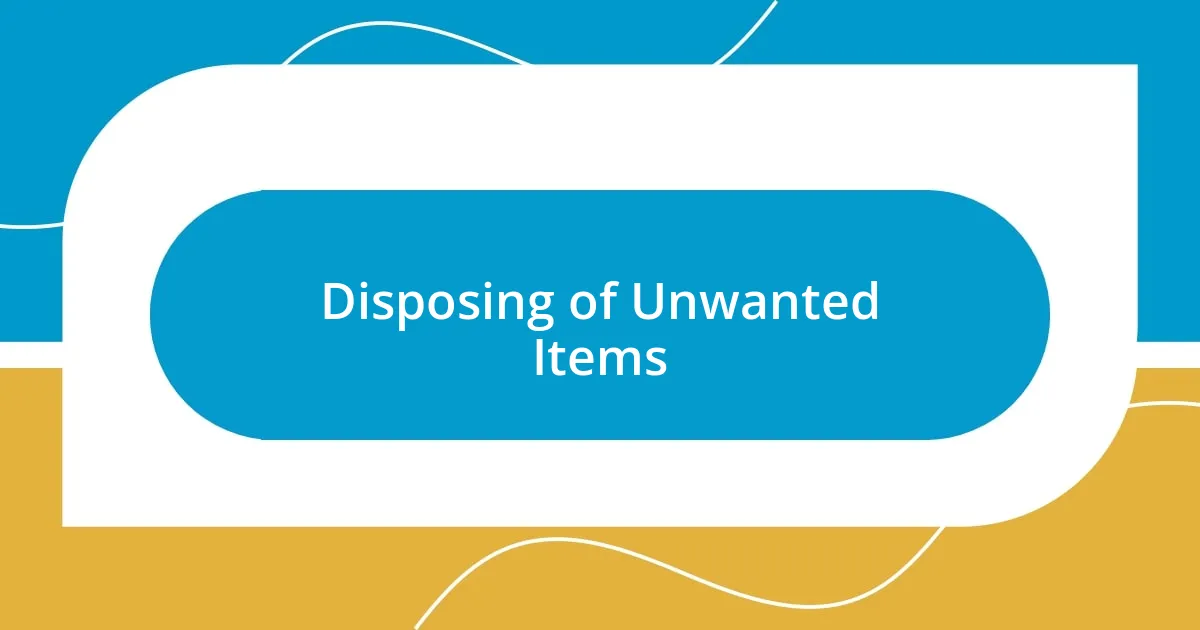
Disposing of Unwanted Items
When it’s time to part with unwanted items, I often think about the spaces they can create. Recently, I found a pair of shoes I wore maybe once because they were simply uncomfortable. As I held them, I realized each item should enhance, not hinder my life. What if someone else could enjoy them instead? This thought becomes my guiding principle, turning the dreaded task of letting go into a rewarding opportunity for others.
I’ve experimented with several ways to dispose of these items and have found that donation is often the most fulfilling option for me. I remember packing up clothes and shoes for a local charity, feeling a sense of purpose with each item I placed in the bag. Knowing that my once-loved clothes would find new homes warmed my heart. Have you considered how your unwanted pieces might uplift someone else’s wardrobe?
For those items that are beyond saving, I’ve turned to recycling, which always feels like a responsible choice. There’s something empowering about being mindful of waste. I once discovered an organization that recycles fabric scraps, and now I make it a point to utilize their services whenever I can. It’s comforting to know that even in their final moments, my clothes are contributing to something greater. How do you approach the challenge of disposing of your unwanted items?
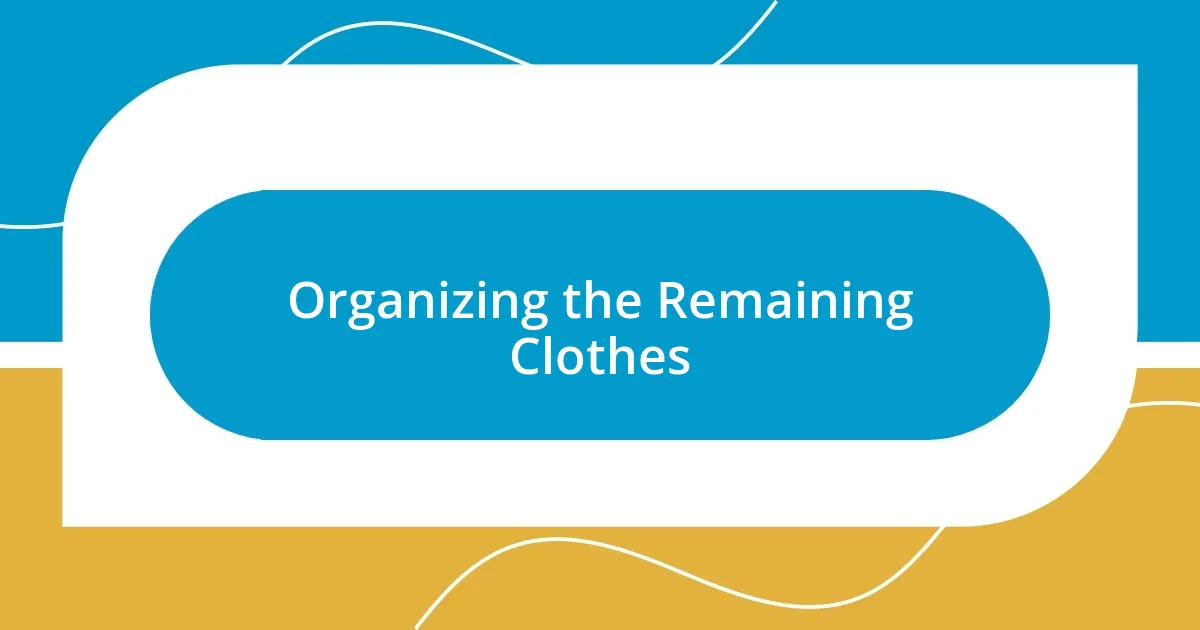
Organizing the Remaining Clothes
After deciding what to keep and parting with what doesn’t serve me, organizing the remaining clothes becomes an exciting chance for creativity. I like to categorize my items into sections—by season, occasion, or even color. For example, creating a section specifically for my workout gear not only keeps things tidy but also motivates me to hit the gym. Have you ever noticed how a little organization can shift your entire mindset about your wardrobe?
I also utilize storage solutions like bins or baskets, which may sound basic, but trust me, they work wonders. I remember finding beautiful wicker baskets at a local market. Instead of hiding my clothes away, I now display my accessories and shoes in these stylish containers. They add an aesthetic touch while keeping everything accessible. Does your closet have elements you love showcasing?
Lastly, I employ a strategic rotation system. I often shift seasonal items to the back or top of the closet when I’m not using them. I once had a collection of winter coats that took up prime real estate, which made my everyday essentials harder to access. After making the switch, it felt like a breath of fresh air every time I opened the closet door. How do you keep your closet feeling fresh and inviting throughout the year?
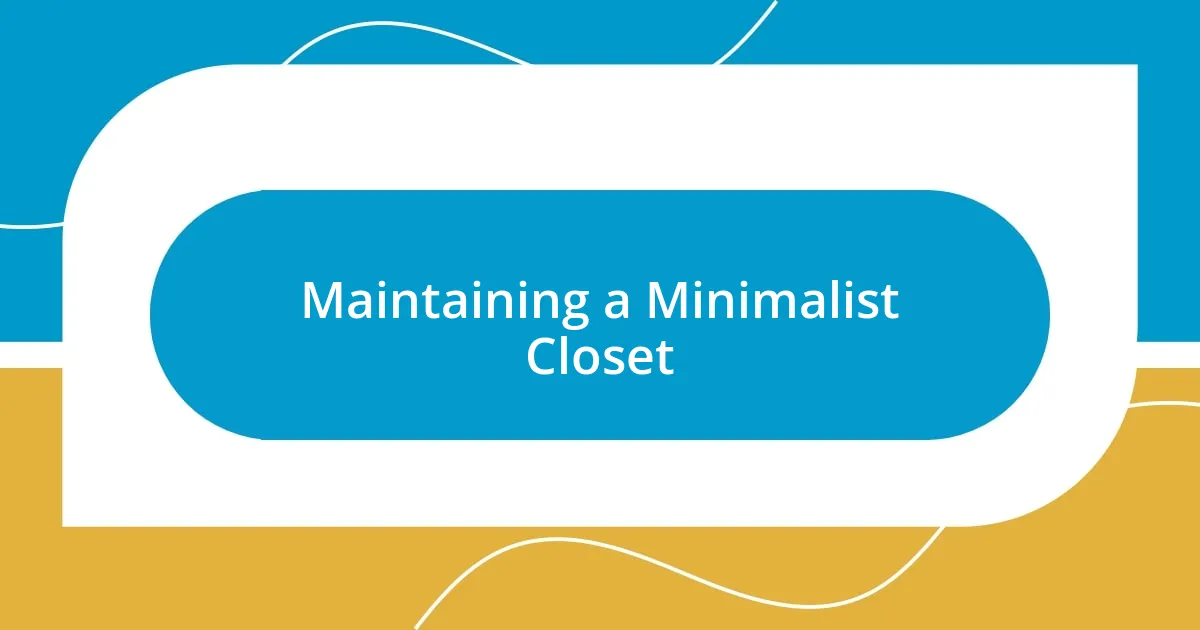
Maintaining a Minimalist Closet
Maintaining a minimalist closet goes beyond simply decluttering; it’s about fostering a mindset of intentionality. I remember the excitement I felt after I ditched an entire bag of clothes that no longer resonated with my style. It was liberating! It made me realize that a minimalist approach isn’t just about having less but embracing what adds value to my life. Does your wardrobe reflect who you are now?
Routine check-ins are key to sustaining this simplicity. I set a reminder every few months to revisit my closet. I often find myself reigniting a personal connection with my clothes and determining if they still spark joy. Just last week, I pulled out a sundress that used to make me feel vibrant but noticed it had become a mere hanger. Letting go of it felt cathartic, like shedding the weight of expectation. How often do you assess the harmony of your closet?
I also believe in investing in quality over quantity. Instead of acquiring a multitude of fast-fashion items, I opt for timeless pieces that align with my values and style. There’s a particular pair of boots I splurged on two years ago. They’ve aged beautifully and go with nearly everything I own, proving that a well-chosen item outlasts fifty mediocre ones. Have you considered how investing in fewer, better pieces could transform your wardrobe experience?












